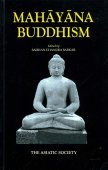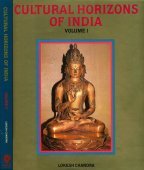Avadana, Avadāna: 19 definitions
Introduction:
Avadana means something in Buddhism, Pali, Hinduism, Sanskrit, the history of ancient India, Marathi, Jainism, Prakrit. If you want to know the exact meaning, history, etymology or English translation of this term then check out the descriptions on this page. Add your comment or reference to a book if you want to contribute to this summary article.
In Hinduism
Purana and Itihasa (epic history)
Source: archive.org: Shiva Purana - English TranslationAvadāna (अवदान) refers to the act of “cutting into pieces”, according to the Śivapurāṇa 2.2.36. Accordingly, as Vīrabhadra said to Indra (and others):—“[...] On account of your childishness you came here for this glorious act. I shall now offer you avadāna (i.e. I shall cut you to pieces). Come near me. O Indra, O Agni, O Sun, O Moon, O Kubera, O Varuṇa, O Wind, O Nirṛti, O Yama, O Śeṣa, O Devas and Asuras, O clever ones, come here. I shall give you avadānas. The boon will be tasted by you till you are satiated”.
Note: Avadāna means a sacrificial gift as well as cutting one to pieces.

The Purana (पुराण, purāṇas) refers to Sanskrit literature preserving ancient India’s vast cultural history, including historical legends, religious ceremonies, various arts and sciences. The eighteen mahapuranas total over 400,000 shlokas (metrical couplets) and date to at least several centuries BCE.
In Buddhism
Mahayana (major branch of Buddhism)
Source: Wisdom Library: Maha Prajnaparamita SastraAvadāna (अवदान) refers to one of the twelve members of Buddhist texts (dvādaśāṅga), according to a note attached to the Mahāprajñāpāramitāśāstra chapter 51.—The avadānas ‘stories’ are amusing little tales (mṛdukathā) such as there are among people in the world. For example:
- In the Madhyāgama: the Tch’ang a-po-t’o-na (Dīrghāvadāna);
- In the Dīrgāgama: the Ta a-po-t’o-na (Mahāvadāna),
- In the Vinaya: the Yi-eul a-po-t’o na (Koṭikarṇāvadāna)
- and the Eul-che-yi a-po-t’o-na (Koṭiviṃśāvadāna),
- In the two hundred and fifty rules (śikṣāpada): the Yu a-po-t’o-na (Chandāvadāna) in one book
- and the P’ou-sa a-po-t’o-na (Bodhisattvāvadāna) in one book.
There are innumerable avadānas of this kind.

Mahayana (महायान, mahāyāna) is a major branch of Buddhism focusing on the path of a Bodhisattva (spiritual aspirants/ enlightened beings). Extant literature is vast and primarely composed in the Sanskrit language. There are many sūtras of which some of the earliest are the various Prajñāpāramitā sūtras.
India history and geography
Source: Cologne Digital Sanskrit Dictionaries: Indian Epigraphical GlossaryAvadāna.—also spelt āvadāna (EI 28, 29, 33), Od8iyā; a present; a tax; tax in general; also called āvedana. (SITI), same as Sanskrit avasāna; termination, end. Note: avadāna is defined in the “Indian epigraphical glossary” as it can be found on ancient inscriptions commonly written in Sanskrit, Prakrit or Dravidian languages.

The history of India traces the identification of countries, villages, towns and other regions of India, as well as mythology, zoology, royal dynasties, rulers, tribes, local festivities and traditions and regional languages. Ancient India enjoyed religious freedom and encourages the path of Dharma, a concept common to Buddhism, Hinduism, and Jainism.
Languages of India and abroad
Pali-English dictionary
Source: Sutta: The Pali Text Society's Pali-English DictionaryAvadāna, see apadāna. (Page 82)

Pali is the language of the Tipiṭaka, which is the sacred canon of Theravāda Buddhism and contains much of the Buddha’s speech. Closeley related to Sanskrit, both languages are used interchangeably between religions.
Marathi-English dictionary
Source: DDSA: The Molesworth Marathi and English Dictionaryavadāna (अवदान).—n (S) A handful of the materials prepared for oblation cast into the fire. 2 fig. Swallowing or gulping a bribe or douceur: also fraudulently appropriating; embezzlement or peculation: also the douceur or the embezzlement. v māra, dē. Pr. gṛhasthāsa a0 bhikṣukāsa śayyādāna or kārakunāsa a0 bhaṭāsa mahādāna.
Source: DDSA: The Aryabhusan school dictionary, Marathi-Englishavadāna (अवदान).—n A handful of the materials prepared for oblation cast into the fire. Fig. Swallowing or gulping a bribe, fraudulently appropriating, embezzlement.
Marathi is an Indo-European language having over 70 million native speakers people in (predominantly) Maharashtra India. Marathi, like many other Indo-Aryan languages, evolved from early forms of Prakrit, which itself is a subset of Sanskrit, one of the most ancient languages of the world.
Sanskrit dictionary
Source: DDSA: The practical Sanskrit-English dictionaryAvadāna (अवदान).—
1) A pure or approved occupation.
2) An accomplished act.
3) A valorous or glorious act, prowess, heroic act, heroism, glorious achievement; संगीयमानत्रिपुरावदानः (saṃgīyamānatripurāvadānaḥ) Kumārasambhava 7.48; Śiśupālavadha 7.2,18.16; प्रापदस्त्रमवदान- तोषितात् (prāpadastramavadāna- toṣitāt) R.11.21; Kirātārjunīya 17.16; तत्त्वत्पूर्वावदानेभ्यो न रोचते (tattvatpūrvāvadānebhyo na rocate) Daśakumāracarita 52; Kirātārjunīya 3.43,13.32.
4) Object of a legend.
5) Objection; जुहुयान्मूलमन्त्रेण षोडशर्चावदानतः (juhuyānmūlamantreṇa ṣoḍaśarcāvadānataḥ) Bhāgavata 11.27.41 Sacrificial object for an oblation.
Derivable forms: avadānam (अवदानम्).
--- OR ---
Avadāna (अवदान).—[ava-do-lyuṭ]
1) Cutting or dividing into pieces.
2) A part, portion; हृदयाद्यवदानानाम् (hṛdayādyavadānānām) Ś. B.
3) Transgression.
4) The root of a plant (vīraṇa); see अवदान (avadāna) also.
Derivable forms: avadānam (अवदानम्).
Source: Cologne Digital Sanskrit Dictionaries: Edgerton Buddhist Hybrid Sanskrit DictionaryAvadāna (अवदान).—nt. (= Pali apadāna), name of a part, or parts, of the Buddhist canon (and of other Buddhist works): Mahāvyutpatti 1273; colophons of Divyāvadāna, Avadāna-śataka, etc. See also sāvadānam. The word avadāna occurs in Sanskrit; its exact meaning is much disputed; see e.g. Speyer, Avadāna-śataka Preface p. I ff.
Source: Cologne Digital Sanskrit Dictionaries: Shabda-Sagara Sanskrit-English DictionaryAvadāna (अवदान).—n.
(-naṃ) 1. Approved occupation. 2. An act accomplished. 3. Achievement, a great or glorious act. 4. Breaking, dividing. 5. The root of a fragrant grass; see avadāha. An oblation. E. ava, dai to cleanse, to purify, or dā to give, and lyuṭ aff.
Source: Cologne Digital Sanskrit Dictionaries: Benfey Sanskrit-English DictionaryAvadāna (अवदान).—i. e. ava-dai + ana, n. A heroic deed, [Daśakumāracarita] in
Avadāna (अवदान).—1. [neuter] cutting off or a part cut off.
--- OR ---
Avadāna (अवदान).—2. [neuter] heroic deed, exploit.
Source: Cologne Digital Sanskrit Dictionaries: Monier-Williams Sanskrit-English Dictionary1) Avadāna (अवदान):—[=ava-dāna] [from ava-dāta] 1. ava-dāna n. a great or glorious act, achievement (object of a legend, [Buddhist literature]), [Śakuntalā; Raghuvaṃśa xi, 21; Kumāra-sambhava vii, 48.] (For 2. ava-dāna See ava√do.)
2) [=ava-dāna] [from ava-do] 2. ava-dāna n. cutting or dividing into pieces, [Śatapatha-brāhmaṇa] etc.
3) [v.s. ...] a part, portion, [Śatapatha-brāhmaṇa; Kātyāyana-śrauta-sūtra]
4) [v.s. ...] = ava-dāha (See sub voce ava-√dah), [cf. Lexicographers, esp. such as amarasiṃha, halāyudha, hemacandra, etc.]
Source: Cologne Digital Sanskrit Dictionaries: Yates Sanskrit-English DictionaryAvadāna (अवदान):—[ava-dāna] (naṃ) n. Approved occupation; breaking; achievment; a fragrant grass; oblation.
Source: DDSA: Paia-sadda-mahannavo; a comprehensive Prakrit Hindi dictionary (S)Avadāna (अवदान) in the Sanskrit language is related to the Prakrit word: Avadāṇa.
[Sanskrit to German]
Sanskrit, also spelled संस्कृतम् (saṃskṛtam), is an ancient language of India commonly seen as the grandmother of the Indo-European language family (even English!). Closely allied with Prakrit and Pali, Sanskrit is more exhaustive in both grammar and terms and has the most extensive collection of literature in the world, greatly surpassing its sister-languages Greek and Latin.
Prakrit-English dictionary
Source: DDSA: Paia-sadda-mahannavo; a comprehensive Prakrit Hindi dictionary1) Avadāṇa (अवदाण) in the Prakrit language is related to the Sanskrit word: Avadāna.
2) Āvaḍaṇa (आवडण) also relates to the Sanskrit word: Āpatana.
Prakrit is an ancient language closely associated with both Pali and Sanskrit. Jain literature is often composed in this language or sub-dialects, such as the Agamas and their commentaries which are written in Ardhamagadhi and Maharashtri Prakrit. The earliest extant texts can be dated to as early as the 4th century BCE although core portions might be older.
Kannada-English dictionary
Source: Alar: Kannada-English corpusAvadāna (ಅವದಾನ):—
1) [noun] a laudable, glorious deed.
2) [noun] an accomplished act.
3) [noun] personal bravery, courage esp. as displayed in fighting; valour.
4) [noun] a heroic achievement.
Kannada is a Dravidian language (as opposed to the Indo-European language family) mainly spoken in the southwestern region of India.
Nepali dictionary
Source: unoes: Nepali-English DictionaryAvadāna (अवदान):—n. contribution;
Nepali is the primary language of the Nepalese people counting almost 20 million native speakers. The country of Nepal is situated in the Himalaya mountain range to the north of India.
See also (Relevant definitions)
Partial matches: Dana, Ava, Tana.
Starts with: Avadanaka, Avadanakalpalata, Avadananem, Avadanavada, Avatanam.
Ends with (+112): Ambhojavadana, Anritavadana, Apratirupavadana, Arthavadana, Arvavadana, Ashokavadana, Ashvavadana, Asokavadana, Atulavadana, Avavadana, Avyavadana, Bhadravadana, Bhandavadana, Bimbapratibimbadarshanavadana, Candravadana, Caturasravadana, Chandravadana, Chaturasravadana, Cudapakshavadana, Dainyavadana.
Full-text (+936): Avadanakalpalata, Kapishavadana, Paryavadana, Avadanika, Apatana, Caturavatta, Avadaniya, Kapphina, Pancavadana, Karmashuddha, Vadanya, Pancavatta, Punyabala, Caturavattin, Vadika, Kauravya, Jambala, Sthulakoshthakiya, Alpeshakhyatva, Virupa.
Relevant text
Search found 38 books and stories containing Avadana, Avadāna, Ava-dana, Ava-dāna, Avadāṇa, Āvaḍaṇa; (plurals include: Avadanas, Avadānas, danas, dānas, Avadāṇas, Āvaḍaṇas). You can also click to the full overview containing English textual excerpts. Below are direct links for the most relevant articles:
Maha Prajnaparamita Sastra (by Gelongma Karma Migme Chödrön)
Part 2 - Hearing the twelve-membered speech of the Buddha < [Chapter LI - Seeing all the Buddha Fields]
Seventh aṅga (member): Avadāna < [Part 2 - Hearing the twelve-membered speech of the Buddha]
Part 7 - Why does Śāriputra question? < [Chapter XVI - The Story of Śāriputra]
Gobhila-grihya-sutra (by Hermann Oldenberg)
Apastamba Grihya-sutra (by Hermann Oldenberg)
Khadira-grihya-sutra (by Hermann Oldenberg)
Paraskara-grihya-sutra (by Hermann Oldenberg)
Amaravati Art in the Context of Andhra Archaeology (by Sreyashi Ray chowdhuri)
Sarvaṃdadavadāna (Sibi Jātaka) < [Chapter 3 - Amarāvatī and the Formative Stage of the Buddhist Art]
Kavikumāravadāna < [Chapter 3 - Amarāvatī and the Formative Stage of the Buddhist Art]
Religious background of early Andhra Pradesh < [Chapter 3 - Amarāvatī and the Formative Stage of the Buddhist Art]
Related products

